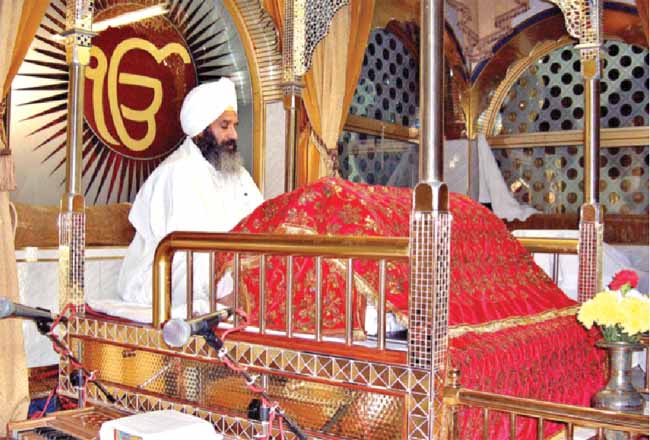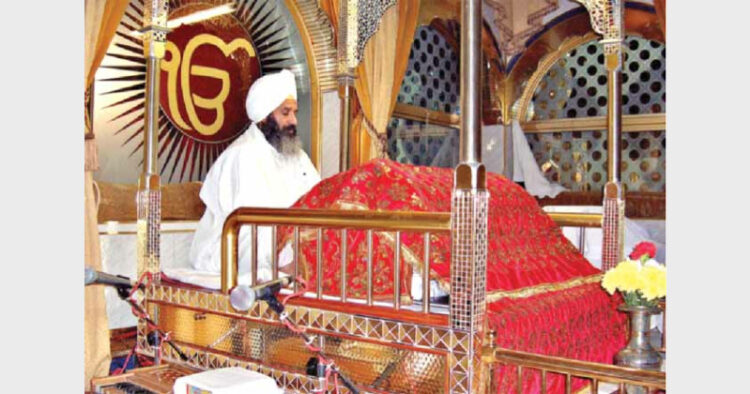Sikhs ask for visaah daan during their daily prayers. Through Yoga one can experience the real meaning of this prayer
-Jagpreet Luthra

Vi-sah, a Punjabi word for vi-shwas, is a blend of two words, vi (without) and sah (breath). The daily concluding prayer of the Sikhs asks for, among other things like man neevaan (humility) and mat(i) uchchi (high spiritual intelligence), “visah daan” or the boon to be without breath. While the commonly understood meaning of visah—faith–was obvious to me, I found the literal meaning strange and confounding. How can being without breath be considered a boon when breath itself stands for life?
However, the practice of a couple of Yogic breathing techniques under the guidance of a guru, I discovered, can lead to a state of being “without breath” and open doorways to the divine world. Ujjai or abdominal breathing, and nadi-shodhan, which involves rhythmic and slow breathing along with an awareness of the sushumna, ida and pingla nadis running along the length of the spine in the pranic layer of the body, both lead to a proper flow of prana or energy in the body. Practiced on an empty stomach, and ideally, early morning, when the air is fresh, these yogic breathing practices bring down the heart rate and induce great stillness.
In yogic language, the cessation of breath is called kumbhak. When the breath ceases, it is an experience that can only be roughly described: it is as though I am absorbed in a limitless and deep black surface
After just 20 to 30 minutes of doing such breathing one gets transported to another world in which one loses awareness of the body itself. During this phase, there is a wonderful lightness and a subtle mix of silence and soft sounds. Sometimes, one gets to hear the faraway jingle of bells and the beat of drums while the music of crickets seems to be coming from close. Slowly, even the sounds vanish and the breath seems conspicuous by its absence. I don’t know the process by which it happens or when the big leap from deep breathing to being unaware of my breath takes place, but it does.
Shiv Ayurveda
We follow an ancient Himalayan tradition of Shiva Ayurveda connected to the Himalayan plants and waters of the domain of Shiva and the great Yogis. It is connected to many Himalayan Yoga traditions from Kashmir to Uttar Khand and Nepal.
While most people look upon Lord Dhanvantari, an incarnation of Lord Vishnu, as the deity of Ayurveda and ideal doctor, in the oldest Rigveda it is Rudra/Soma, Lord Shiva himself who is the supreme doctor (bhishaktamam tva bhishajam shrinomi). In the Yajurveda, Rudra is the very personification of the healing ritual (Yajna) that grants wellbeing and longevity (Ayu). All healing Prana and healing mantras come through his power and his Yoga Shakti.
Shiva’s Rudra form connected to Agni purifies body and mind and removes toxins. Shiva’s Soma form relates to the healing plants, fruit, fragrances rasayana and rejuvenation. The entire universe is Agni and Soma, which is Shiva as Fire and the Moon. Shiva as Mrityunjaya, the one who takes us across death, also takes us across disease and sorrow. For Shiva Ratri let us remember Shiva Ayurveda, Shiva and immortality and the role of Shiva, which means peace and balance in all healing practices.
Progressing into this state, the mind also becomes still and one can feel the silence expanding with every moment. The nothingness that follows is absorbing. On days that I can remain deep and long in this state, it actually feels that the breath has stopped. In yogic language, the cessation of breath is called kumbhak. When the breath ceases, it is an experience that can only be roughly described: it is as though I am absorbed in a limitless and deep black surface.
I have no idea where I go—more appropriately, where my ‘I’ goes–during kumbhak. But I do know that it is not very nice to be back. To breathe means to be aware of ‘I’ with all its trappings: to think, look, see, smell, hear, feel and yap, among a thousand other things. To be without breath is so liberating. There is a vast, impenetrable peace in this state which is so alluring that I want to remain there. Now, I know why Sikhs ask for visaah daan during their daily prayers. The boon is mine for the asking. All I have to do is practice the yogic breathing techniques, of course, strictly under the guidance of a guru.
(The writer is a senior journalist, based in Delhi)













Comments